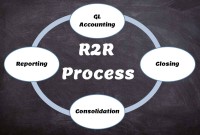- Home
- Business Processes
- Industry Knowledge
- Aerospace Industry
- Automotive Industry
- Banking Domain
- BFSI Industry
- Consumer/ FMCG Industry
- Chemicals Industry
- Engineering & Construction
- Energy Industry
- Education Domain
- Finance Domain
- Hospitality Domain
- Healthcare Industry
- Insurance Domain
- Retail Industry
- Travel and Tourism Domain
- Telecom Industry
- Leadership Skills
- eLearning
- Home
- Business Processes
- General Ledger (Record to Report)
- Defining Reporting Dimensions
Defining Reporting Dimensions
Multitude of these legal and operational structures clubbed with accounting and reporting needs give rise to many reporting dimensions at which the organization may want to track or report its operational metrics and financial results. This is where business dimensions play a vital role.
Multitude of these legal and operational structures clubbed with accounting and reporting needs give rise to many reporting dimensions at which the organization may want to track or report its operational metrics and financial results. This is where business dimensions play a vital role.
Business Dimensions:
A dimension reflects the attributes of a business, such as legal structure, management structure, departments and projects. Dimensions are used to help capture and analyze underlying data and when used with reporting provides an effective tool to break down key components of business to help make better business decisions. Business dimensions describe the business-specific objects within the model, such as products, customers, regions, employees, and so on.
Why we need business dimensions:
In any typical entity, accounting process starts with recording of a transaction that has a financial implication on a voucher and it culminates with the preparation of final books of accounts. However this simple process gains complexity when the size of the organization and diversity of its environment increases. For example: Global companies regularly distribute goods from a central site to customers located in different countries or regions. Before shipping lo a customer, goods may be processed through a separate operating unit or subsidiary in the country of sales origin. A complex sequence of coupled accounting records is needed because these transactions impact multiple organizations and legal entities, and most governments require a financial record for transactions conducted between legal entities. Management need to contemplate these business dimensions properly for decision-making and enhancing the achievement of the competitive advantage and control over the operations of the enterprise.
- There exist various types of entities or business units which are part of the same global group.
- These units may represent countries, locations, businesses, functions, projects, cost centers, segments etc.
- These units may have different reporting needs.
- These units may be responsible for their own profit and loss.
- They might be holding their own Fixed Assets.
- They might be concerned with their own markets where their products are sold.
- They might be constituted as separate legal entities over multiple layers of ownership with their peculiar independent local statutory reporting needs.
- Subsidiaries and branches operating as individual entities need to be consolidated with the group financials.
Examples of different dimensions are:
- Legal Entity: Financial results and trial balance at each legal entity level
- Division/Department: Financial results and trial balance at each division or department
- Product Line: Operating margins for each product line
- Geography: Annual Growth for each geography in which a company operates
- Project: Cost and profitability for each project undertaken by business
- Cost Center: Costs accumulated and allocated through each cost center
- Accounts: Total fixed assets owned by the legal entity, accounted under land and building, furniture and fixtures and other accounts
- Functional Area: Total cost attributable to each function like finance, marketing etc.
These dimensions further have parent child relationships within themselves and other corporate relationships (known as Business Hierarchies) with other dimensions. Corporate relationships are the links between various dimensions like parent companies, subsidiaries, headquarters, branches, functions, product lines, cost centers etc. A dimension may consists of one or more hierarchies that can contain several levels.
Related Links
You May Also Like
-
GL - Journal Posting and Balances
In this tutorial, we will explain what we mean by the posting process and what are the major differences between the posting process in the manual accounting system compared to the automated accounting systems and ERPs. This article also explains how posting also happens in subsidiary ledgers and subsequently that information is again posted to the general ledger.
-
Funds contributed by owners in any business are different from all other types of funds. Equity is the residual value of the business enterprise that belongs to the owners or shareholders. The funds contributed by outsiders other than owners that are payable to them in the future. Liabilities are generally classified as Short Term (Current) and Long Term Liabilities. Current liabilities are debts payable within one year.
-
Although technically a general ledger appears to be fairly simple compared to other processes, in large organizations, the general ledger has to provide many functionalities and it becomes considerably large and complex. Modern business organizations are complex, run multiple products and service lines, leveraging a large number of registered legal entities, and have varied reporting needs.
-
Introduction to Legal Entities Concept
Modern business organizations operate globally and leverage a large number of registered legal entities, and operate through complex matrix relationships. To stay competitive in the current global business environment, they must often develop highly diverse and complex organizational structures that cross international borders. Learn more about Legal Entities and their importance for businesses.
-
Period End Accruals, Receipt Accruals, Paid Time-Off Accruals, AP Accruals, Revenue Based Cost Accruals, Perpetual Accruals, Inventory Accruals, Accruals Write Off, PO Receipt Accrual, Cost Accrual, etc. are some of the most complex and generally misconstrued terms in the context of general ledger accounting. In this article, we will explore what is the concept of accrual and how it impacts general ledger accounting.
-
Reversing Journals are special journals that are automatically reversed after a specified date. A reversing entry is a journal entry to “undo” an adjusting entry. When you create a reversing journal entry it nullifies the accounting impact of the original entry. Reversing entries make it easier to record subsequent transactions by eliminating the need for certain compound entries. See an example of reversing journal entry!
-
Record to report (R2R) is a finance and accounting management process that involves collecting, processing, analyzing, validating, organizing, and finally reporting accurate financial data. R2R process provides strategic, financial, and operational feedback on the performance of the organization to inform management and external stakeholders. R2R process also covers the steps involved in preparing and reporting on the overall accounts.
-
What Is a General Ledger? General Ledger (also known in accounting as the GL or the Nominal Ledger) is at the heart of any accounting system. A general ledger is the master set of accounts that summarize all transactions occurring within an entity. Ledger is the skillful grouping and presentation of the Journal entries. Learn the accounting fundamentals, general ledger process, and general ledger flow.
-
In every journal entry that is recorded, the debits and credits must be equal to ensure that the accounting equation is matched. In this article, we will focus on how to analyze and recorded transactional accounting information by applying the rule of credit and debit. We will also focus on some efficient methods of recording and analyzing transactions.
-
For any company that has a large number of transactions, putting all the details in the general ledger is not feasible. Hence it needs to be supported by one or more subsidiary ledgers that provide details for accounts in the general ledger. Understand the concept of the subsidiary ledgers and control accounts.
Explore Our Free Training Articles or
Sign Up to Start With Our eLearning Courses

About Us
Learning
© 2023 TechnoFunc, All Rights Reserved











